A day before the always-stimulating Google Zeitgeist conference at the search-engine giant’s Mountain View campus a few weeks ago, I had the privilege of participating in a day devoted to advertising agencies and marketing inventiveness. My role was simple: I was to moderate to panel on innovation, featuring five pioneering interactive companies, all of them, in their own ways, direct or indirect competitors. The panelists were Tim Armstrong of Google, Randy Falco of AOL, Brian McAndrews of Microsoft, Mike Murphy of Facebook, and Michael Barrett of MySpace.
 But as we prepared for our two-hour session, I was worried. As much as our hosts wanted to talk about innovation, there was, I knew, an elephant in the room: industry consolidation. Microsoft’s acquisition of aQuantive (of which Mr. McAndrews had been the CEO), Google’s pending purchase of DoubleClick, the rise of social networking, the mainstreaming of digital video, to name just a few trends, were generating apprehension across the marketing-media value chain. The concern was captured in the now-famous term the WPP Group’s Chief Executive, Sir Martin Sorrell, applied to Google at the Zeitgeist conference just one year before: “frenemy.”
But as we prepared for our two-hour session, I was worried. As much as our hosts wanted to talk about innovation, there was, I knew, an elephant in the room: industry consolidation. Microsoft’s acquisition of aQuantive (of which Mr. McAndrews had been the CEO), Google’s pending purchase of DoubleClick, the rise of social networking, the mainstreaming of digital video, to name just a few trends, were generating apprehension across the marketing-media value chain. The concern was captured in the now-famous term the WPP Group’s Chief Executive, Sir Martin Sorrell, applied to Google at the Zeitgeist conference just one year before: “frenemy.”
“We must show a willingness to address consolidation, disintermediation, reintermediation, ‘frenemization,’ and all manner of these Latinate concerns,” I suggested to my fellow panelists, “else we’ll be accused of ducking.” All readily agreed.
Came the panel. Finished with introductions, I turned to the table of 10 advertising-agency executives — an assembly of the most accomplished men and women in the business, gathered from creative agencies, media agencies, diversified services agencies, regional agencies, and global agencies — and put the matter to them. We will address everything that interests and concerns you, I said, but what would you rather take up first: innovation or consolidation?
The immediate reply: “Innovation.”
And no matter how many times I tried to bait the agency executives, no matter how many times I tried to get them to start a “frenemy” discussion, they just would not rise to it.
“You must understand,” said one, “that we understand what’s happening to the landscape, and while there are obvious concerns, we really need to know more about the opportunities. What we want to know most is how you can help us build value for our clients.”
“Teach Me” Moment
We are in what I call a “teach-me moment.” Everywhere I turn, the apprehensions of a year ago are, if not banished, significantly diminished. In their place, across the value chain, is a desire to learn, to improve, to acquire new capabilities, and to collaborate in unfamiliar ways to build customer relationships and new business opportunities.
I call this revised view of marketing-media coopetition “Ecosystem 2.0.” I suspect it will dominate our waking hours for the foreseeable future. And I know that we at the IAB will be paying close attention to it – for we intend to make it a centerpiece of our association’s 2008 strategy.
I’ve talked in previous posts about how and why the new complexities and opportunities of marketing require unfamiliar forms of collaboration across the value chain. It was clear the message resonated: IAB’s MIXX Conference & Expo, which was themed around the new collaborative landscape, sold out for the first time in its history.
But there’s increasing evidence that this evangelical message is winning converts, even in more orthodox precincts – including marketing departments. In “Marketing-Media Ecosystem 2010,” the study done by the global management consulting firm Booz Allen Hamilton for the IAB, the Association of National Advertisers, and the American Association of Advertising Agencies, one of the key findings was the degree to which marketing executives are seeking new types of relationships to buttress their own capabilities.
For example, more than half of the most digitally savvy marketers believe that having direct relationships with media companies – “publishers,” in the surprisingly jejune industry parlance – is more important than going through an agency. More than 40 percent of these digital leaders believe the marketer-media relationship will increasingly resemble the relationship between retail giants like Walmart and their main consumer-product suppliers – that is, major media companies are likely to have consultative teams embedded at marketing companies to aid with insights development, program creation, and cross-platform utilization. Indeed, almost three-fourths of digitally savvy marketers are adding positions to help them optimize publisher relationships.
Hence Booz Allen’s conclusion that in the transforming marketing-media ecosystem, “media is the new creative.”
Agencies Want Guidance
Agencies increasingly are aware that they have to rise to this challenge, and gain capabilities that will enhance their value to their clients. The AAAA has placed emphasis on the development of “consultative selling” capabilities at agencies. And more and more, I see agencies turning to interactive media companies for guidance, even capability-building help.
Publishers must learn how to respond. “We need you [interactive companies] to come to us in a different way,” one agency president said at the Google roundtable I moderated. “Instead of just sending your salespeople to talk to our media planners, we need you to send your savviest technology people to talk to our creatives. We need to get your analytics experts to talk to our account planners.” His fellow agency executives agreed.
The agencies, though, need to match wishes with actions. As much as their leaders profess deep interest in learning more about applying interactive platforms, applications, brands and opportunities to their client work, their troops aren’t necessarily following. Many IAB members say that when they try to set up broader meetings at agencies, the right people too often do not come to the table. At the media agencies, in particular, discussions still center predominately on price, not value.
Agencies need to bring senior team leaders into the room. They must strive to break down the walls that not only have kept publishers, too frequently, in their traditional place — as “dumb” conduits for the agencies’ ads – but have kept agency functions siloed from each other. Cross-functional collaboration must begin at home, else it will never take root between and among companies.
Media companies are similarly challenged. For years, “branded publishers” have maintained a wary distance from “the portals.” They have worried that these eyeball-aggregators are using their “front door” status as well as search engines, free email and other services to legally tap into the publishers’ content to amass audiences and sell advertising that otherwise would go to the content sites. Now that the portals are evolving into platforms, the apprehension, in some quarters, is growing.
I believe it’s wiser – certainly, it’s more realistic – for publishers and agencies alike to determine how and where they can play with the platforms to enhance their own capabilities, and thus their value to clients.
The Platform Environment
Platform, admittedly, is a vague word – “a swirling vortex of confusion,” Netscape founder and Ning chief Marc Andreessen says. But Mr. Andreessen offers a simple explanation. “A ‘platform,'” he writes, “is a system that can be programmed and therefore customized by
outside developers – users – and in that way adapted to countless needs and niches that the platform’s original developers could not have possibly contemplated, much less had the time to accommodate.”
 To one degree or another, the major Internet giants appear to be following Mr. Andreessen’s definition. Several of them are evolving into platform companies that are building advertising exchanges — stock-market-like mechanisms that connect advertising buyers and sellers, price available inventory, and clear it in real time — and integrating them with their growing multi-site advertising networks. These platforms, in effect, marry a liquidity mechanism to a pool of inventory, a continuing flow of behavioral data, and analytics and optimization tools that can automate many of the expensive people-centric processes that have typified advertising for generations.
To one degree or another, the major Internet giants appear to be following Mr. Andreessen’s definition. Several of them are evolving into platform companies that are building advertising exchanges — stock-market-like mechanisms that connect advertising buyers and sellers, price available inventory, and clear it in real time — and integrating them with their growing multi-site advertising networks. These platforms, in effect, marry a liquidity mechanism to a pool of inventory, a continuing flow of behavioral data, and analytics and optimization tools that can automate many of the expensive people-centric processes that have typified advertising for generations.
AOL’s acquisition of Tacoda (and, just last week, Quigo) and the consolidation of it, Advertising.com, and other services and network businesses is demonstrably an effort to position AOL as a platform – hence the name of its new business, Platform A. Google’s development and acquisition of various open platforms and its pending purchase of Doubleclick (which is starting up an ad exchange) is another example of platforming. So is Microsoft’s acquisition and integration of aQuantive, the AdECN exchange, and other services. And so is Yahoo’s acquisition of the Right Media exchange and its services buildout.
Could platforms represent another threat to content sites – an effort to aggregate and monetize their audience without them? Sure. But it’s very telling that the intended transformation of the social networking site Facebook into a platform has been accompanied by enormous interest by major content developers. Every day, it seems, heralds a new Facebook application from The New York Times, the Washington Post, Conde Nast, or another premium publisher. They believe that open platforms can represent opportunity as much as threat. In a dramatic turnabout, they a chance to take the aggregator’s audience and enhance the publisher’s brand, reach, and stickiness.
Indeed, rather than positioning themselves to “own the world,” as branded publishers feared during the era of the “portals,” the new platforms seem to be wanting to develop scalable businesses that can add value to others’ businesses in the marketing-media value chain.
“Live by Openness”
At the Right Media Open last month, I had the privilege of conducting an on-stage interview with Yahoo’s co-founder and new CEO, Jerry Yang. He was explicit about his platform’s value proposition to others. He defined a platform as “a business that has a set of standards that allows a set of companies to participate and find benefit from it.” The key to success, he indicated, would be the platform’s availability to players across the value chain. “Yahoo will have to embrace openness,” Mr. Yang told me. “We must live by openness, leverage the data to be smarter and improve upon our partnerships with important companies like Comcast.”
I like Mr. Yang’s definition of platform more than Mr. Andreessen’s, if only because the latter, focused as it is on systems, seems more of an engineering construct than a social construct – and because, ultimately, the value-additive collaboration that Mr. Yang foresees will require tapping into real human needs, emotions, and satisfactions. I’d even go Mr. Yang one further: A platform is a collection of scaled or scalable services that help players up and down the value chain grow their customers’ businesses, and their own businesses in turn.
While there is reason for publishers and agencies to feel threatened by the evolution of the platforms, more and more of them seem to be perceiving them as opportunities, as Mr. Yang would have them do. Mike Walrath, the founder and CEO of Right Media, the exchange that was acquired earlier this year by Yahoo, spoke directly (albeit with background noise on the Flip camera) to the issue when I queried him specifically on the subject of advertising exchanges and commoditization at his conference.
Joe Fiveash, Senior Vice President and General Manager of Weather.com and a member of IAB’s Board of Directors, agreed that the opportunities presented by the platforms must be explored. While aware of the pitfalls of commoditization, he, too, saw more to embrace than to fear in the ad exchanges and the platforms.
Small players are arising to realize the advantages Mr. Fiveash foresees to grow the overall marketplace. As Yahoo’s Developer Network Director Matt McAllister blogged at the Right Media Open, there is “an interesting market of middlemen that I didn’t know existed.  For example, I spoke with a guy from a company called exeLate that serves as a user behavior data provider between a publisher and an exchange. There were also ad services providers like Text Link Ads and publishers like Jim Mansfield’s PhoneZoo all discussing the tricky aspects of managing the mixture of inventory, rates and yield, relationships with ad networks, and the advantages of using exchanges.”
For example, I spoke with a guy from a company called exeLate that serves as a user behavior data provider between a publisher and an exchange. There were also ad services providers like Text Link Ads and publishers like Jim Mansfield’s PhoneZoo all discussing the tricky aspects of managing the mixture of inventory, rates and yield, relationships with ad networks, and the advantages of using exchanges.”
My point is a simple one: As Ecosystem 2.0 evolves, we’re likely to benefit from thinking more about symbiosis than about victory. If you’re looking for an image to carry you through a 2008 that will be at least as tumultuous as 2007, I’d recommend one from my scuba days: Not dolphins and sharks, but clownfish and anemones. It looks scary, but it’s mutually beneficial.